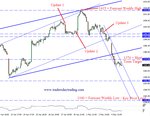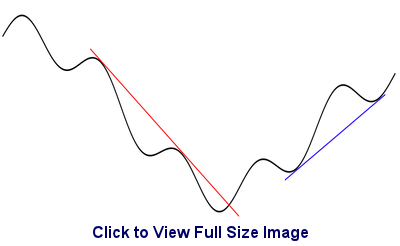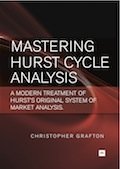Hurst
Cycles Analysis Methods
Hurst
Cycles Analysis Methods
Part 2 of an
Introduction to J.M Hurst Cycles Analysis and Trading Methods. Article
submitted by
Christopher Grafton, Author of "Mastering Hurst Cycle Analysis".
Hurst Trading Cycles Defined
In Fig 3.7 below, we can see how cycles start at a low point,
the cycle trough 'A', and then advance to a high point, the cycle
peak 'C'. This is the cycle upswing. From the peak,
the
cycle
then falls through its downswing to a second adjacent trough to
'E'.
For
argument’s sake, let’s suppose that the cycle falls back to the same
level as it started from.
The time between the two cycle troughs is the period, or the length of
the cycle and the height from trough to peak is the
amplitude.
|
|

The longer the period, the more power
the
cycle has and the larger the amplitude. It makes sense that
an 18
month cycle will move prices further up and down than a 20 week cycle.
Fig3.7 Mastering Hurst Cycles Analysis
|
Hurst
Cycles Analysis
Contents Index
Related Pages
|
Valid Trend line (VTL)
Analysts like to draw trend lines on charts as they give a sense of
order and sometimes generate trading signals. Quite often,
however, trend lines are subjective and tell us little about the
underlying market.
What we perceive as price action is simply a composite of cycles of
different magnitudes. Each cycle from the shortest to the
longest contributes to the composite and the net effect is
trend.
Thus, if the longest of the Hurst's cycles are all advancing together
then the
longer
term trend is up and shorter Hurst cycles will experience successively
higher
troughs.
|
Kennys Technical Analysis

Kennys Elliott Wave Analysis is my trading plan for
the week ahead with regular updates.
Technical analysis reports using
Elliott waves, chart patterns, trend trading strategies, Hurst cycles
and other stock market
time cycles analysis.
Kennys
Elliott Wave Analysis |
Hurst Cycles Analysis - Valid Trend Line (VTL)
 Imagine Fig 2.16A
shows a
twenty week cycle with a flat underlying trend. If a straight
line connecting adjacent cycle lows is projected into the future a
horizontal line is plotted. Think of this as a trend support
line. Now imagine that the twenty week cycle swinging back
and forth around a longer cycle which is heading up. The line
connecting the troughs now points up and starts to look more like a
trend line. Imagine Fig 2.16A
shows a
twenty week cycle with a flat underlying trend. If a straight
line connecting adjacent cycle lows is projected into the future a
horizontal line is plotted. Think of this as a trend support
line. Now imagine that the twenty week cycle swinging back
and forth around a longer cycle which is heading up. The line
connecting the troughs now points up and starts to look more like a
trend line.
Because it is based on a rule (connecting adjacent troughs of the same
cycle) it is objective. However think about what happens as
the longer cycle tops and begins to turn down, it forces the twenty
week cycle through the turn as well and the line connecting the troughs
(the valid trend line) is crossed from above by the twenty week cycle.
When the valid trend Line (VTL) is cut we therefore know that the next
longer Hurst cycle has reversed.
Fig
2.16A Mastering Hurst Cycle Analysis
By making the trend line objective and by redefining trend in terms of
cycles, Hurst’s valid trend lines (VTL) gives us a clear insight into
price structure and tells us the magnitude of recent reversals.
Hurst Cycles Analysis - Forward Line of
Demarcation (FLD)
The second of JM
Hurst cycles trading tools is conceptually a little more
challenging. Imagine a perfect cycle with, let’s say, a
period of 14 days and amplitude of USD20. It takes seven days
for the cycle to peak and another seven days for it to trough
again. Now imagine a duplicate cycle that starts up seven
days later, such that when the first cycle peaks the second troughs and
when the first cycle troughs the second peaks. The cycles are
therefore out of phase, or put more accurately, they are in anti-phase.
When the lead cycle crosses the lagging cycle from above we know two
things: that the first cycle has peaked; that the peak must be a half
cycle back; that its next trough will occur in one half cycle period’s
time and that it will cover the same vertical distance to the next
trough (USD7).
Displacing cycles in this way is the essence of the somewhat cumbrously
named Forward Line of Demarcation (FLD). Thus, if we plot a replica 20
week market 10 weeks forward in time, when prices crosses it we know
that a 20 week cycle trough or peak must have passed within
the last 10 weeks and we know roughly how far prices have to travel to
the next 20 week peak or trough.
If projections are overshot, then we know that a longer cycle is
trending in the same direction (pro-cyclical) as the one under
observation. If on the other hand projections are undershot,
then we know that a longer cycle is trending in the opposite direction
(counter cyclical) as the one under observation. Although
there is a bit more to it than that, that is the basic idea.
We use FLDs to project future prices, tell us the strength of
underlying trend and ascertain the magnitude of recent reversals.
Now lets look at a practical example in a
weekly Hurst trading cycles analysis
of the S&P500 Index
|
John Murphy Video (90 Min)
Let John Murphy guide you through his thought process in selecting
markets to trade, in this Free 90 min video. This classic video is
still one of the most insightful you are ever going to see on investing
and trading.
Among Other
Free Videos Available
- Using
Pattern Probability to Trade with the Trend: Curtis Arnold
- Market
Wizard Insights: Jack Schwager
- Options
- Learn The Greeks: Ron Ianieri
Watch
John Murphys "Applying Technical Methods to Today's Trading" for Free. |
Mastering Hurst Cycle Analysis
 A
modern treatment of JM Hurst's
original
system of financial market analysis A
modern treatment of JM Hurst's
original
system of financial market analysis
by Christopher Grafton
Pages: 384
Published: 30 Nov 2011
|
Free
Guide
Elliott Wave
PDF
Free to
download, the Traders
Day Trading free Elliott
Wave Theory PDF quick start guide. Download it free now
for a quick
overview of the basics.
It is a handy reference guide to the
basics of the wave patterns and wave formation.
|
Search Traders Day Trading
|
Stock Market
Trading Basics
|
Technical
Analysis Guide
|
Learning About
The Stock Market
|
|